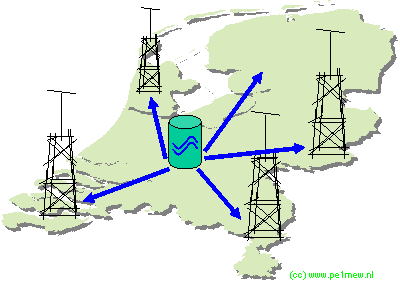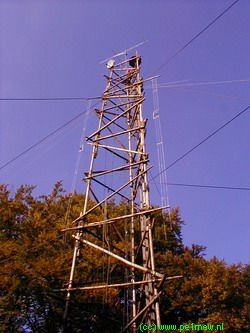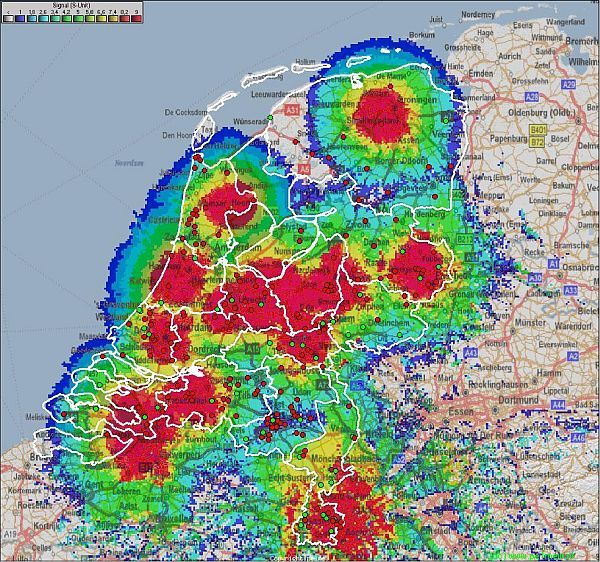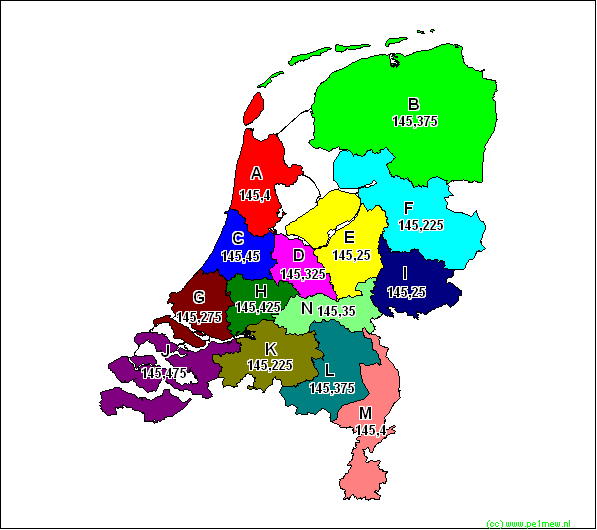|
For the dutch opening of the JOTA-JOTI each year in october the Dutch NAtional JOTA-JOTI organisation (www.jota-joti.nl) is setting up the Dutch national station PA6JAM (or PA50JAM like in 2008). Also the national station starts the Dutch JOTA-JOTI with a opening ceremony that can be listened at on 80 and 2 meters. The aim of this station is to reach all the participating dutch scouting groups on both 2 and 80 meters.
To do this a relative simple station is set up on 80 meters but to reach all the scouting groups on 2 meters is a different job.
The opening ceremony is prepared in the week before the JOTA-JOTI and available in MP3 format. On the evening of the opening of JOTA-JOTI using a shoudcast server the transmission is distributed on the internet to 13 local stations that retransmit the stream om 2 meters. These stations connect there shoutcast client via the soundcard to their 2 meter transmitter and PTT manually.

Principle of the Shoutcast distribution network
To verify if all participating scout groups can listen to PA6JAM on 2 meters, Radio Mobile is used to do some analysis. Originally Radio Mobile is used for the RF calculations and a aditional program MapInfo for the presentation and analysis of the result. However the analysis could have been done in Radio Mobile as well.
Used features
In this analysis example the following features of Radio Mobile are used:
The broadcast network consists of 13 stations spread around the Netherlands. These stations are operated by RJJA, Rayon JOTA-JOTI advisors. These are scouts that advise participating scoutgroups technical and scouting issuses in conjunction to JOTA-JOTI. The RJJA have a task in broadcasting the shoutcast stream and to be able to do so they setup a 2 meter station randomly located in their district.
Based on their feedback we know where they are located ond so we can create units that represent their station. From registration we know where the scoutgroups are located.
we know from experience that generally two type of stations operate: a omni at 9 meters and a omni at average 12 meters. the 9 meter station is the typical QTH of a radioamateur and the 12 meter station is a typical JOTA station setup where a 12 meter tower is made by scouts and the omni is put on top.

Typical JOTA scout pioneering tower.
A normal station uses a commercial VHF rig and has about 15 watt available. on average these rig's are quite sensitive so 0,22 dbuV is assumed at 12 dB Sinad. That is very comfortable for a scout.
Also it is asumed that the average scoutgroup has a cable loss of at least 4 dB due to bogus cables and bad connectors. the antenna gain is asumed 5 dBi (2 dBd).
The analysis
The broadcast and receiving station are asumed to have equal setup as 10 out of 13 stations are located at scout groups participating in JOTA-JOTI.
The following linkbudget is applicable
TX power +42 dB
TX Cable loss 4 dB
TX Antenna gain 2 dBd
RX antenna gain 2 dBd
RX Cable loss 4 dB
Minimum RX level -120 dBm
As all stations are static no margin is taken for lognormal- and raleigh fading
Maximum Allowed Path Loss (MAPL) 42- 4 + 2 + 2 - 4 + 120 = 158 dB
Now we know this we can compute the composite coverage (combined cartasian) of this network.
Please note that this performance is ony for stations that have the parameters as discribed in the unit properties for this analysis.
When we take the positions of the JOTA-JOTI groups in account we can determine if we have reached our goal: can all the JOTA-JOTI groups listen on VHF to the opening ceremony.

From this image we can determine that only 1 group of 0ver 200 will have to listen om 80 meters.
That is a success of 99,5 %
The frequencyplan
To be able to have that many stations at the same time on the air frequencys must be coordinated.

The objective of the plan is to avoid co-channel interference and allow the participating scouts stations to listen to their regional station without the interference of the other region.
Therefore reused frequencys are maximaly separated. Region M and A are a good example. The frequency in region D is not reused.
|